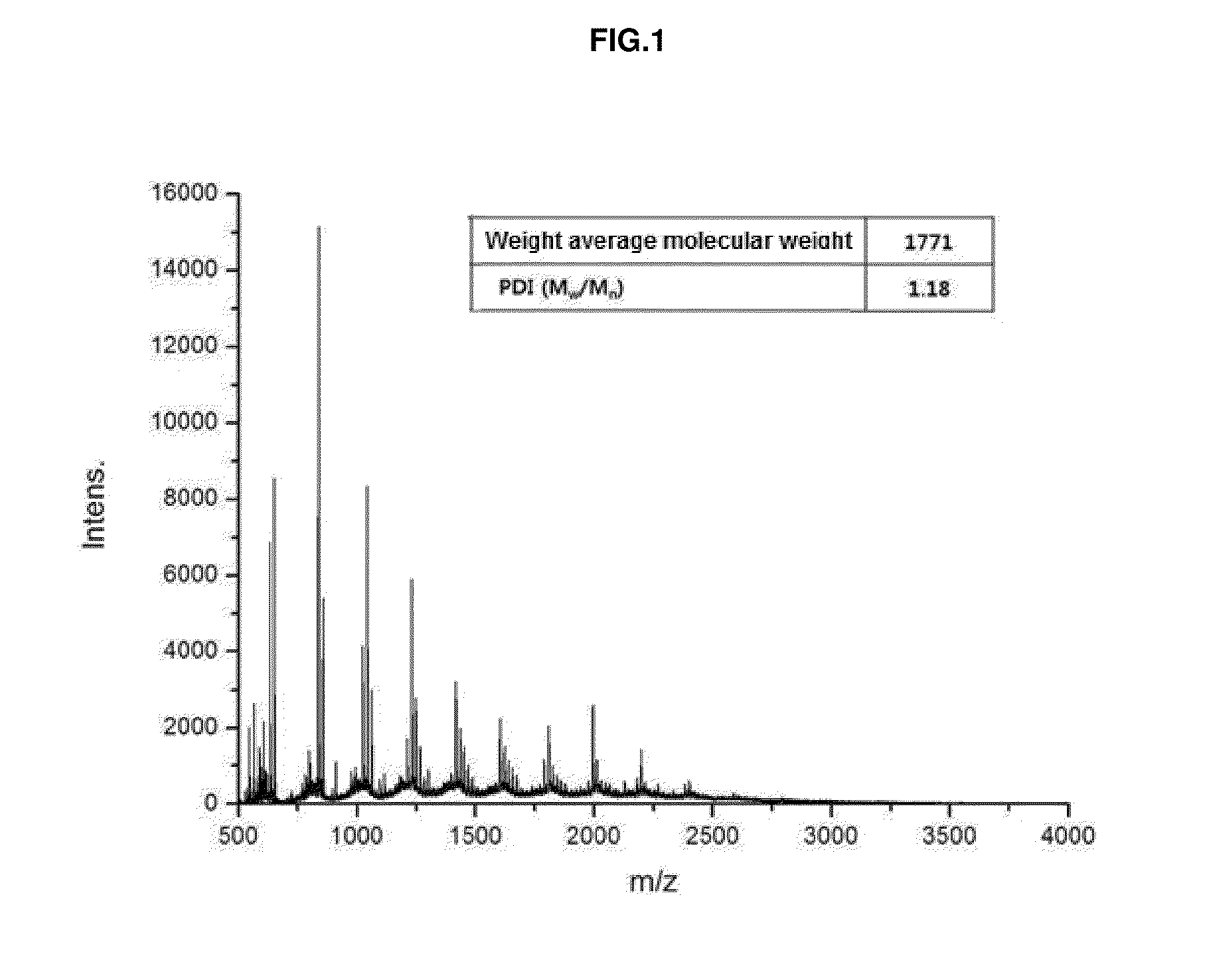Siloxane hard coating resin
a technology of hard coating and siloxane, which is applied in the direction of instruments, semiconductor/solid-state device details, instruments, etc., can solve the problems of low flexibility and moldability, low abrasion resistance of plastic resins, and still unsatisfactory, and achieves high surface hardness, high hardness, and easy processing
- Summary
- Abstract
- Description
- Claims
- Application Information
AI Technical Summary
Benefits of technology
Problems solved by technology
Method used
Image
Examples
example 1
Photopolymerization
[0049]2-(3,4-epoxycyclohexyl)ethyltrimethoxysilane (ECTMS, Gelest) and water (H2O, Sigma-Aldrich) were mixed at a ratio of 24.64 g:2.70 g (0.1 mol:0.15 mol), and then put into a 100 ml 2-neck flask. Thereafter, 0.05 ml of ammonia as a catalyst was added to the mixture, and stirred at 60° C. for 6 hours. The mixture was filtered using 0.45 μm Teflon filter, thereby obtaining an alicyclic epoxy siloxane hard resin. The molecular weight of the alicyclic epoxy siloxane hard resin was measured using a Matrix-Assisted Laser Desorption Ionization Mass Spectrometer, and shown in the following FIG. 1. By using this measured value, it was confirmed that the alicyclic epoxy siloxane hard resin has a number average molecular weight of 1498, a weight average molecular weight of 1771, and PDI (Mw / Mn) of 1.18.
[0050]Next, an aryl sulfonium hexafluoroantimonate salt as a polymerization initiator for photopolymerization was added in an amount of 2 parts by weight, based on the resu...
example 2
Photopolymerization
[0052]2-(3,4-epoxycyclohexyl)ethyltrimethoxysilane (ECTMS, Gelest) and water (H2O, Sigma-Aldrich) were mixed at a ratio of 24.64 g:2.70 g (0.1 mol:0.15 mol), and then put into a 100 ml 2-neck flask. Thereafter, 0.05 ml of ammonia as a catalyst was added to the mixture, and stirred at 60° C. for 6 hours. The mixture was filtered using 0.45 μm Teflon filter, thereby obtaining an alicyclic epoxy siloxane hard resin. The molecular weight of the alicyclic epoxy siloxane hard resin was measured using a Matrix-Assisted Laser Desorption Ionization Mass Spectrometer, and shown in the following FIG. 1. By using this measured value, it was confirmed that the alicyclic epoxy siloxane hard resin has a number average molecular weight of 1498, a weight average molecular weight of 1771, and PDI (Mw / Mn) of 1.18.
[0053]Next, 3-ethyl-3[[3-ethyloxetan-3-yl]methoxy]methyl]oxetane as a photopolymerizable monomer was added in an amount of 20 parts by weight, based on the resultant resin,...
example 3
Thermal Polymerization
[0055]2-(3,4-epoxycyclohexyl)ethyltrimethoxysilane (ECTMS, Gelest) and water (H2O, Sigma-Aldrich) were mixed at a ratio of 24.64 g:2.70 g (0.1 mol:0.15 mol), and then put into a 100 ml 2-neck flask. Thereafter, 0.05 ml of ammonia as a catalyst was added to the mixture, and stirred at 60° C. for 6 hours. The mixture was filtered using 0.45 μm Teflon filter, thereby obtaining an alicyclic epoxy siloxane hard resin. The molecular weight of the alicyclic epoxy siloxane hard resin was measured using a Matrix-Assisted Laser Desorption Ionization Mass Spectrometer, and shown in the following FIG. 1. By using this measured value, it was confirmed that the alicyclic epoxy siloxane hard resin has a number average molecular weight of 1498, a weight average molecular weight of 1771, and PDI (Mw / Mn) of 1.18.
[0056]Next, 4-methyl-1,2-cyclohexene dicarboxylic anhydride as a thermal polymerizable monomer was added in an amount of 90 parts by weight, based on the resultant resin...
PUM
| Property | Measurement | Unit |
|---|---|---|
| PDI | aaaaa | aaaaa |
| molecular weight distribution | aaaaa | aaaaa |
| temperature | aaaaa | aaaaa |
Abstract
Description
Claims
Application Information
 Login to View More
Login to View More - R&D
- Intellectual Property
- Life Sciences
- Materials
- Tech Scout
- Unparalleled Data Quality
- Higher Quality Content
- 60% Fewer Hallucinations
Browse by: Latest US Patents, China's latest patents, Technical Efficacy Thesaurus, Application Domain, Technology Topic, Popular Technical Reports.
© 2025 PatSnap. All rights reserved.Legal|Privacy policy|Modern Slavery Act Transparency Statement|Sitemap|About US| Contact US: help@patsnap.com



